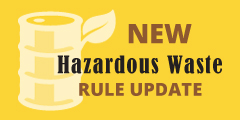Changes to Hazardous Waste Regulations
 On November 28, 2016, the Environmental Protection Agency (EPA) issued a final rule that significantly revises hazardous waste generator regulations. These revisions provide less stringent requirements for many hazardous waste generators and become effective on May 17, 2017. The revised regulations are intended to improve compliance and program effectiveness, clarify existing regulations, address regulatory gaps, and reduce the regulatory burden for hazardous waste generators. Most of the generator requirements have been consolidated into Title 40 of the Code of Federal Regulations (CFR) part 262 (and reduces cross-references to parts 261 and 265). Over 60 changes were made to the hazardous waste generator regulations. A few critical changes are highlighted below:
On November 28, 2016, the Environmental Protection Agency (EPA) issued a final rule that significantly revises hazardous waste generator regulations. These revisions provide less stringent requirements for many hazardous waste generators and become effective on May 17, 2017. The revised regulations are intended to improve compliance and program effectiveness, clarify existing regulations, address regulatory gaps, and reduce the regulatory burden for hazardous waste generators. Most of the generator requirements have been consolidated into Title 40 of the Code of Federal Regulations (CFR) part 262 (and reduces cross-references to parts 261 and 265). Over 60 changes were made to the hazardous waste generator regulations. A few critical changes are highlighted below:
CESQG Replaced by VSQG
Conditionally exempt small quantity generator (CESQG) has been replaced by the term very small quantity generator (VSQG). The hazardous waste generation rates and accumulation quantity limits that determined a CESQG remain the same for a VSQG.
The revised rule allows VSQGs to send hazardous waste to a large quantity generator (LQG) under the control of the same person (this provides the ability to consolidate the waste prior to transporting to a RCRA-designated facility). There is no limit on the amount or type of hazardous waste that a LQG can receive from a VSQG. The regulations stipulate container labeling, recordkeeping, and management. The LQG must notify EPA (EPA Form 8700-12) at least 30 days prior to receiving the first shipment from the VSQG.
New Conditions for an Irregular Event
The revised rule allows both SQGs and VSQGs to maintain their generator category even if a planned or unplanned event generates an unusually larger quantity of hazardous waste (that may otherwise increase the hazardous waste category). This regulatory reprieve for an “episodic” event is allowed once per calendar year, and the generator does not count this episodic hazardous waste as part of the standard monthly quantity. A generator can appeal the EPA for a second event, under certain circumstances, within the new regulations. VSQG would also have to obtain an EPA ID number for a planned or unplanned episodic event.
Generators must notify EPA at least 30 days prior to a planned episodic event (using EPA Form 8700-12) or within 72 hours of an unplanned event (via phone, fax, email, or follow-up submittal of EPA Form 8700-12).
The new regulations require onsite accumulation or storage of hazardous waste from an episodic event in containers or tanks and specify labeling, recordkeeping and inventory. These requirements are found in new part 262.232.
Hazardous waste generated during an episodic event must be manifested to an offsite RCRA-designated facility within 60 days of the start of the event. EPA indicates that multiple projects completed within that 60-day time limit would be considered part of the same episodic event if the start and end dates are provided on the notification (81 FR 85783).
New part 262 also specifies conditions for SQGs to manage wastes during an episodic event including emergency preparedness/prevention and employee training. In addition, VSQGs waste management must minimize release of hazardous exposure to the environment.
LQGs and Recycling Facilities – Changes to Biennial Reporting
The new regulations clarify that a generator who is an LQG for at least one month of the reporting year must submit a biennial report which includes all hazardous waste generated in the entire reporting year (not just the months the facility was an LQG). The biennial report must include hazardous waste received from VSQGs under their control. EPA recognizes that states may have equivalent or more stringent requirements.
The new regulations add the requirement of biennial reporting to facilities who receive and recycle hazardous wastes without storing them.
SQG/LQG Renotification Requirements
The final rule introduces renotification requirements for SQGs and LQGs (not included in previous regulations). Beginning in 2021 and every four (4) years thereafter, SQGs must renotify EPA by September 1 (EPA Form 8700-12). LQGs must renotify EPA by March 1 of each even-numbered year as part of their biennial report (EPA Form 8700-12).
LQG Requirements for Facility Closure
The final rule introduces requirements for closing an LQG facility (not included in previous regulations). The LQG must notify EPA (EPA Form 8700-12) at least 30 days prior to closing the facility. The LQG must again notify EPA (EPA Form 8700-12) within 90 days after closing the facility, stating that it has complied with the standards of new part 262 for all 90-day accumulation units.
SQG/LQG Emergency Response and Contingency Planning
The conditions for emergency response and contingency planning have been revised to include Local Emergency Planning Committees (LEPC) among emergency planning organizations with those a generator may already make arrangements with for emergency response.
The final rule requires the LQG to prepare and submit a quick reference guide to the Contingency Plan Summary (when the Contingency Plan Summary is updated or amended) and submit to local responders.
Additional Information
EPA provides information about the final rule including a Fact Sheet and Summary with frequently asked questions and answers, which can be found at the following links:
Fact Sheet
Summary of Frequently Asked Questions
A compliance gap assessment of your hazardous waste program in preparation for these changes is an effective way to plan revisions needed to your onsite program. If you need assistance, let’s chat! Leave a comment or get in touch directly at info at www.ehscsi.com or 786-258-1818.
